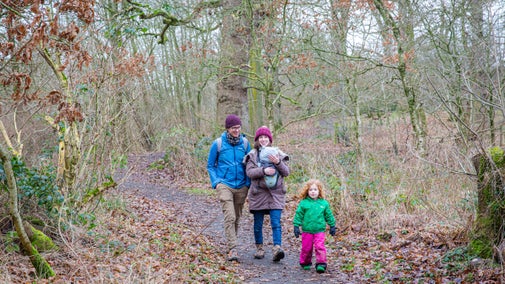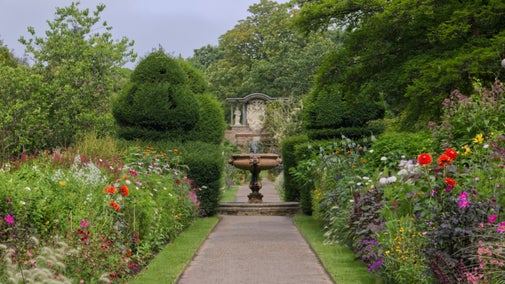
Emmetts Garden's collections
Explore the objects and works of art we care for at Emmetts Garden on the National Trust Collections website.

Emmetts Garden is the work of Frederic Lubbock, a banker and passionate plantsman, who bought the property in 1893 and laid out the garden in the years that followed. Discover the history behind some of the garden areas and what happened after Lubbock’s time.
The South Garden was originally laid out by Lubbock to display some of his most extraordinary species. He bought rare plants from around the world; many had been collected in China on plant huntsman expeditions.
Each tree and shrub was given enough space in the South Garden to show their unique natural form. Look past, through and under each specimen to catch a glimpse of other plants in the distance and the landscape beyond.
An integral part of Lubbock’s plans for the North Garden, or Shrub Garden as it was then known, were the views created from a northern plateau that overlooked a section of the garden and pond. This view then goes beyond to the South Garden and Wealden ridge.
Similar views were designed from the very bottom of the North Garden, stretching up above its rocky slope and rising above the planting towards the original Acer specimen at the top of the garden.
Not just focused on views, Lubbock planned for these specimens to be enjoyed because of the true-to-life conditions they grew in. Water and ponds were used not just as a focal point but to create a 'bog garden', providing growing conditions for moisture-loving plants like iris and ferns.
More shady areas were developed to support 'Japanese' planting including Acer and Magnolia specimens, and a rocky bank created for hot and dry conditions to support cistus and Tree Lupins.
The Italianate rose garden is the only formal part of the garden at Emmetts, and was designed by Frederic Lubbock especially for his wife, Catherine. Created between 1910 and 1920, the Rose Garden was very much a central feature of the original garden design.
The Rose Garden formed a frame for one of the key views from the house out towards the valley and weald of Kent. In the Lubbocks’ time, a smaller square pond formed the centrepiece.
Early photos show that it held a far more diverse range of herbaceous plants than today with standard roses, swags of roses on the terrace between the garden and the house, and large planters on the path.

The tulips in Emmetts Garden sit under the prunus fugenzo, cherry trees native to Japan. The tradition of planting tulips underneath these blossom trees goes back to at least 1910 and the Lubbock family.
Thanks to a discovery of stereoscopic glass slides dating back to this era, we know that it was always the intention to have the tulips and the blossom flowering at the same time and we continue this tradition today.
The slides confirmed both the location of the tulip meadow – which is where you will see it today – and the pink, red and black colour scheme.
Many of the trees and shrubs Lubbock bought for the South Garden originated from China, including the beautiful dove, or handkerchief, tree. These specimens were introduced in Europe in the 19th century and became wildly popular.
For many years China had restricted access to European trade but were forced to make concessions after the First Opium War. Plantsmen were amongst the first merchants and adventurers to seek out the country’s riches.
Ernest Wilson was one of the most prolific commercial collectors, sending back more than 1,800 species in his first two expeditions, totalling many thousands of bulbs, seeds or tubers for the Veitch Nurseries, who came to dominate the market.
Following Lubbock’s death in 1927, Emmetts Garden was acquired by Charles Boise, an American geologist. He kept on George Taylor, Lubbock’s head gardener, for another 34 years, ensuring a sense of continuity.
Boise made various alterations to the garden, including filling in the pond in the North Garden: he was worried that the pond would attract mosquitos and increase his chance of becoming ill with malaria.
He also extended the rock garden, where his wife Hazal introduced azaleas. Boise bequeathed the garden to the National Trust in 1964.
The great storm of 1987 proved devastating to Emmetts Garden with 95 per cent of surrounding woodland lost, taking years to recover. The team at the time saved what they could. For example, a handkerchief tree was blown over and badly damaged, but it was winched upright and is still in place today.
Gardener Alan Comb arrived for his first day of work at Emmetts just after the storm in October 1987. He remarked that the whole area was unrecognisable as the same place he came to for his interview.
- Alan Comb, Gardener at Emmetts Garden
Nearby Toys Hill, the highest point in Kent, lost 98 per cent of its trees. A 20-hectare ‘exclusion zone’ was set up at Toys Hill and surrounding countryside, and the area was left alone to regenerate completely naturally. This has allowed us to study how nature recovers when left without deliberate planting, and has provided key learning points for future conservation efforts.
On a visit to Toys Hill today, you can still see the effects of the storm in the deadwood that continues to lie across the forest floor, even though the area has now made an incredible recovery.

Explore the objects and works of art we care for at Emmetts Garden on the National Trust Collections website.
Take a look behind the scenes at Emmetts Garden in Kent and discover the work that goes into keeping this special place looking its best.

Help us look after this special place by volunteering your time and skills. Make new friends, learn about the estate and share your passion for gardens with people from all walks of life.

Find a garden area to suit your taste here at Emmetts Garden. With different and diverse designs, and views that are always impressive, there's something to see at any time of year.

Enjoy family-friendly fun and outdoor play at Emmetts Garden, all set against a backdrop of a glorious Edwardian garden, on one of the highest points of the Kentish Weald. Invent a game to play in the meadow with inspiration from our toy cupboard, explore the wild play area near the Tea Room or come along for the Winter Wander Family trail.

Learn about people from the past, discover remarkable works of art and brush up on your knowledge of architecture and gardens.

Discover more about the history of the plants, gardens and landscapes in our care.
